Supercharge Summer Fun with a Sweet, Simple Salsa
(Family Features) After a full day at the park or swimming pool, summer fun calls for some refueling. All that sun is sure to exhaust busy families, leaving little time for complicated snacks.
Skip the long ingredients lists and leave confusing cooking instructions behind. Instead, treat your loved ones to this Roasted Sweetpotato Mango Salsa, an easy-to-prepare solution for those busy afternoons.
The natural sweetness of cubed sweetpotatoes (no added sugar required) and mango collide with the delightful crunch of diced bell peppers, onion and jalapeno. Combined with fresh-squeezed orange, lemon and lime juices, it’s equal parts flavor and refreshment served with your favorite chips or crackers.
With complex carbohydrates that provide sustained energy, sweetpotatoes help with both endurance and recovery in athletes, making them a perfect ingredient for reenergizing your family. This nutrition powerhouse is versatile and available year-round so you can enjoy them throughout the summer as part of favorite snacks, weeknight meals or even Saturday morning pancakes.
Pairing them with the more than 20 vitamins and minerals from mangos, which are fat free, sodium free and cholesterol free, makes this salsa a better-for-you snacking solution.
The versatility of sweetpotatoes makes it a cinch to add them to a variety of recipes to enhance flavor and nutrition content, from simple salsas and small bites to elevated recipes and beyond. Plus, they can be baked, microwaved, grilled, slow-cooked or prepared on the stove as a perfect summer sidekick.
Visit ncsweetpotatoes.com to find more recipes that are sure to become summer family favorites.
Watch video to see how to make this recipe!

Roasted Sweetpotato Mango Salsa
Recipe courtesy of the North Carolina Sweetpotato Commission
Servings: 12
- 1 1/2 cups (2 medium) sweetpotatoes
- 1/2 teaspoon salt
- 1/4 teaspoon pepper
- 1/2 tablespoon chili powder
- 2 tablespoons olive oil
- 1 cup mango
- 1/2 green bell pepper
- 1/2 red bell pepper
- 1/2 cup purple onion
- 1 jalapeno
- 1/4 cup cilantro
- 1 tablespoon fresh-squeezed orange juice
- 1 tablespoon fresh-squeezed lemon juice
- 1 tablespoon fresh-squeezed lime juice
- chips or crackers
- Heat oven to 400 F.
- Peel, rinse and cube sweetpotatoes 1/4 inch or smaller. Toss sweetpotatoes with salt, pepper, chili powder and olive oil.
- Spread on baking sheet and roast 20 minutes.
- Peel and cube mango. Seed and cube bell peppers. Dice onion. Seed and dice jalapeno. Finely chop cilantro.
- Once sweetpotatoes cool, mix with mango, peppers, onion and jalapeno. Cover with fresh-squeezed orange, lemon and lime juices.
- Chill and serve with chips or crackers.
Dish Up Protein-Packed Sweet Treats
(Family Features) In a world of packed schedules and boring food, it can feel like doing the healthy thing means giving up some of what makes you happy – like treats and flavors you love. Choosing health shouldn’t mean restricting yourself; everyone deserves a treat now and again.
Try incorporating better-for-you ingredients into your favorite indulgences. Look for convenient, ready-to-use products, like Premier Protein High Protein Shakes, to help infuse the nutrition you need with the joy you deserve. With 30 grams of protein, 160 calories and 1 gram of sugar, the shakes make it easy to take the first step and keep that momentum going, adding nutrient-dense protein to nearly any recipe.
In addition to a smooth, creamy texture, each shake delivers 24 vitamins and minerals including vitamins C and E, which help support a healthy immune system as part of a healthy diet and lifestyle. With 11 flavors – including strawberries & cream and chocolate – there’s an impossibly indulgent option for everyone to make a healthy life a happy endeavor through recipes like Peanut Butter Jelly Ice Cream and Chocolate Ice Cream with “Caramel” Sauce.
Find more information and recipes at PremierProtein.com or on Instagram.
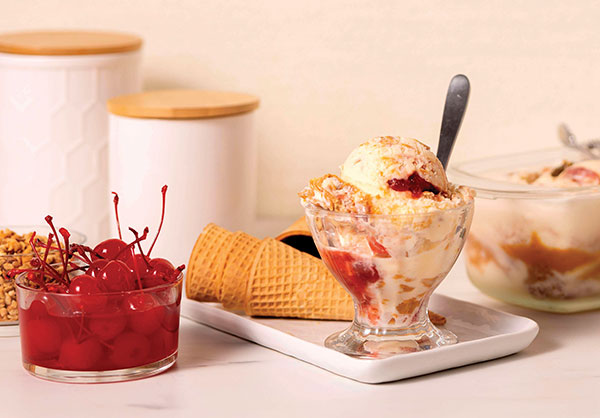
Peanut Butter Jelly Ice Cream
Servings: 12
- 1 cup whole milk
- 1/2 cup Premier Protein Strawberries & Cream Protein Shake
- 1/4 cup packed brown sugar
- 1/2 teaspoon salt
- 1 large egg, lightly beaten
- 2/3 cup creamy peanut butter
- 2 cups heavy whipping cream
- 2 teaspoons vanilla extract
- 1/2 cup sugar-free strawberry jelly
- In large, heavy saucepan, heat milk, protein shake, brown sugar and salt until bubbles form around sides of pan. Whisk small amount of hot mixture into egg. Return to pan, whisking constantly.
- Cook and stir over low heat until mixture thickens and coats back of spoon. Remove from heat; whisk in peanut butter. Quickly transfer to bowl; place in ice water and stir 2 minutes. Stir in cream and vanilla. Press wax paper onto surface of custard. Refrigerate several hours or overnight.
- Fill cylinder of ice cream freezer 2/3 full; freeze according to manufacturer's directions.
- When ice cream is frozen, spoon into freezer container, layering with jelly; freeze 2-4 hours before serving.
Nutritional information per serving: 271 calories; 23 g total fat; 11 g saturated fat; 0 g trans fat; 72 mg cholesterol; 205 mg sodium; 13 g total carbohydrates; 1 g dietary fiber; 8 g total sugars; 6 g protein.

Chocolate Ice Cream with “Caramel” Sauce
Recipe courtesy of "Chelsea's Messy Apron"
Servings: 8
- 1 large sweet potato
- 1 bag (10 ounces) dark chocolate chips, plus additional for topping (optional)
- 2 teaspoons pure vanilla extract
- 1/2 teaspoon fine sea salt
- 1/4 cup coconut sugar
- 1 Premier Protein Chocolate Protein Shake
"Caramel" Sauce:
- 3 tablespoons coconut oil (measured when solid)
- 3 tablespoons real maple syrup
- 1 1/2 tablespoons almond butter
- 1/8 teaspoon fine sea salt
- 1/4 teaspoon pure vanilla extract
- Wash and scrub sweet potato. Pierce with fork several times. Place on microwave-safe plate and microwave 5 minutes; flip and microwave 5 minutes. Allow to cool.
- In microwave-safe bowl, microwave chocolate chips in 20-second increments, stirring between each increment until smooth and melted. Set aside.
- Remove sweet potato skin and thoroughly mash. Pack into 3/4 cup measuring cup. Place in large blender.
- Add melted chocolate to blender along with vanilla, sea salt, coconut sugar and chocolate protein shake.
- Place lid on blender and blend on high at least 1 minute, or until ingredients are smooth and incorporated.
- Transfer to ice cream maker and prepare according to manufacturer's directions then transfer to airtight container and freeze 2-3 hours.
- To make "caramel" sauce: In microwave-safe bowl, microwave coconut oil and syrup 30 seconds. Stir and microwave 30 seconds, or until melted and smooth. Stir in almond butter and whisk until smooth. Add sea salt and vanilla extract; whisk to combine.
- Set "caramel" sauce aside at room temperature about 30 minutes. Top ice cream with sauce and additional chocolate chips, if desired.
Nutritional information per serving: 346 calories; 18 g total fat; 11 g saturated fat; 5 mg cholesterol; 219 mg sodium; 40 g total carbohydrates; 4 g dietary fiber; 31 g total sugars; 7 g protein.
Source:
Make Every Meal Celebration Worthy
(Family Features) Family reunions, birthday celebrations and holiday gatherings all bring loved ones together for special occasions that call for delicious meals and snacks. To help elevate entertaining in your household, make hosting a cinch with quick, shareable recipes.
Pizza, for example, is a nearly universally beloved dish ideal for sharing. This version is simple, fresh and perfect for entertaining guests or just for a night in with fresh mozzarella, Prosciutto di Parma and fresh basil.
For savory seasonal flavor, look no further than Sweet Potato Rounds topped with fried sage leaves, goat cheese and prosciutto. When guests arrive, greet them with easy hors d’oeuvres that balance wellness with indulgence like this Crudites Platter or Fresh Snack Board.
To help ensure the freshest of ingredients in these tasty appetizers, look for the “Parma Crown” on packages of Prosciutto di Parma, which you can find pre-packaged or available for slicing at many gourmet deli counters and specialty food stores. Containing no additives, preservatives or hormones, Parma ham contains no additives, preservatives or hormones and is 100% natural. Aged twice as long as many other options, it creates a depth of flavor that’s delicate and sweet-savory with a buttery texture.
Find more easy appetizers perfect for entertaining at parmacrown.com.
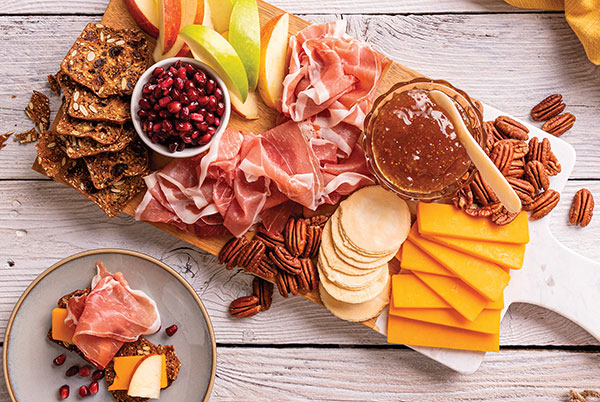
Fresh Snack Board
- 1/3 pound Prosciutto di Parma
- 1 apple, sliced
- 1 handful pecans, walnuts or almonds
- 1/2 cup pomegranate seeds
- 1/2 cup fig jam
- 1/2 pound sharp cheddar cheese, sliced
crackers
- On charcuterie board or platter, arrange prosciutto, apple slices, nuts, pomegranate seeds, fig jam and cheddar cheese slices. Serve with crackers.
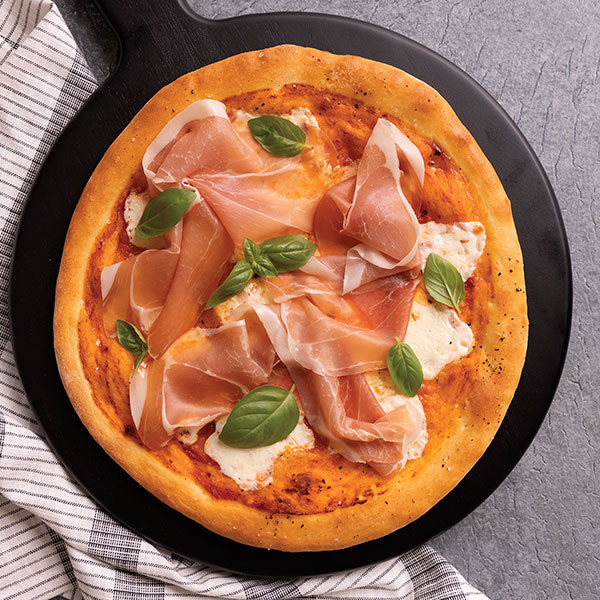
Prosciutto Pizza
Yield: 8 slices
- Olive oil
- flour
- 1 container (16 ounces) store-bought pizza dough
- 1/4 cup tomato sauce
- 4 ounces fresh mozzarella, cubed
- 5 slices Prosciutto di Parma
- 6 fresh basil leaves
- Remove dough from refrigerator and let sit at room temperature at least 30 minutes. Preheat oven to 500 F. Grease baking sheet with olive oil.
- Roll out pizza dough onto floured work surface to form oblong shape about 16 inches long and 12 inches wide. Remove to oiled baking sheet and stretch out edges to fill length of baking sheet.
- Bake 4 minutes. Remove from oven and evenly spread tomato sauce over surface, leaving 1/2 inch from edges bare. Dot with mozzarella. Bake until edges are golden and mozzarella is bubbling, about 12 minutes.
- Drape prosciutto over mozzarella. Garnish with fresh basil.

Sweet Potato Rounds
Yield: 16-20 rounds
- 2 medium sweet potatoes
- 2 teaspoons olive oil
- salt, to taste
- 2 tablespoons butter
- 1 bunch fresh sage, stems removed
- 4 ounces goat cheese
- 8 slices Prosciutto di Parma, halved
- Preheat oven to 425 F. Line baking sheet with foil or parchment paper. Peel and slice sweet potatoes into 1/2-inch rounds. In medium bowl, toss sweet potatoes with oil and lightly season with salt, to taste. Arrange rounds in single layer on prepared pan; bake until sweet potatoes are lightly browned and tender, about 20 minutes, flipping halfway through.
- In small skillet over medium heat, bring butter to simmer. Add half the sage leaves. Cook until crispy, 2-3 minutes. Remove to paper towel and season lightly with salt, to taste. Repeat with remaining sage leaves. Reserve 2 teaspoons butter. In small food processor, combine goat cheese and reserved butter; whirl until smooth.
- To make rounds, remove goat cheese to plastic zip-top bag. Cut off one corner and pipe small dollops of cheese onto each round. Top with half slice prosciutto and one crispy sage leaf.
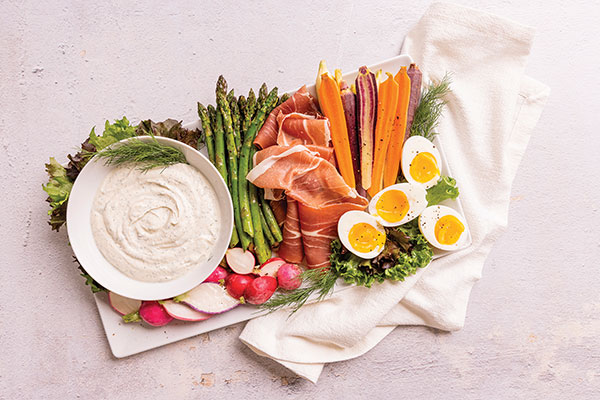
Crudites Platter
Platter:
- 8 asparagus
- water
- 2 soft-boiled eggs
- 5 baby carrots, halved lengthwise
- 4 radishes with tops, halved lengthwise
- 1 head little gem lettuce, quartered
- 6-8 slices Prosciutto di Parma
Dip:
- 2 teaspoons white miso
- 1 tablespoon lemon juice
- 1 teaspoon water
- 1/2 cup full-fat Greek yogurt
- 2 tablespoons chopped herbs (dill, tarragon or parsley)
- 1/4 teaspoon salt
- fresh black pepper, to taste
- To make platter: Trim asparagus. To blanch, bring pot of water to boil and place asparagus in pot 2-3 minutes. While asparagus is cooking, fill large bowl with ice water. After 3 minutes, plunge asparagus in ice bath and let cool.
- To soft-boil eggs, bring pot of water to boil. Gently place room temperature eggs in water and simmer 3-4 minutes. Remove eggs with slotted spoon and cool under running water.
- Serve asparagus and eggs alongside baby carrots, radishes and little gem lettuce. Drape prosciutto slices over some vegetables and between others.
- To make dip: In small bowl, whisk miso, lemon juice and water until smooth. Add yogurt, herbs and salt. Season generously with cracked pepper, to taste; mix and serve with platter.
Source: Prosciutto di Parma
Quick, Easy Recipes to Add to Your Dinner Rotation: Simple, nutritious meals to make more time for family
(Family Features) Making time for meals together can have a positive impact on the well-being of families, including children and adolescents. In fact, regular meals at home can help reduce stress and boost self-esteem, according to research published in “Canadian Family Physician.”
Mealtime conversations are also a perfect opportunity to connect with your loved ones. A study published in “New Directions for Child and Adolescent Development” showed these conversations help improve children’s vocabularies more than being read aloud to.
Making time for meals together shouldn’t require spending all night in the kitchen, however. A simple-to-prepare ingredient like eggs can help you spend less time cooking and more time with family.
For example, these heart-healthy recipes for Poached Egg Tostadas with Avocado-Tomatillo Salsa, Sweet Potato Hash with Eggs and Poblano Frittata from the Healthy for Good Eat Smart initiative, nationally supported by Eggland’s Best, are ready in 15 minutes or less. They include a wide variety of vegetables, fruit, whole grains and healthy protein sources, which are recommended by the American Heart Association to help prevent heart disease and stroke.
To find more tips for family mealtimes and recipe inspiration, visit heart.org/eatsmart.
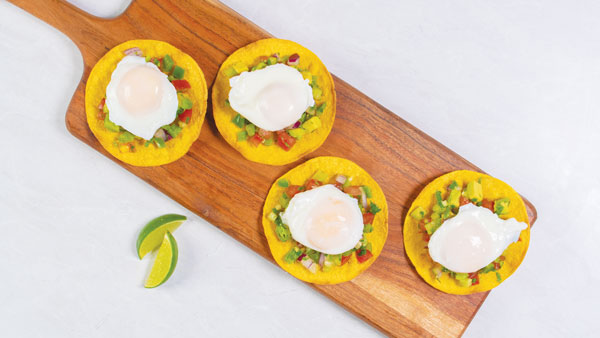
Poached Egg Tostadas with Avocado-Tomatillo Salsa
Servings: 4 (1 egg and 1/2 cup salsa per serving)
- Nonstick cooking spray
- 4 corn tortillas (6 inches each)
- 4 cups water
- 1 tablespoon white vinegar
- 4 large eggs
Salsa:
- 1 medium avocado, diced
- 1 medium Anaheim or poblano pepper, seeds and ribs discarded, diced
- 1 medium tomatillo, papery husk discarded, washed and diced
- 1/2 medium tomato, diced
- 1/4 cup diced red onion
- 1/4 cup chopped fresh cilantro
- 2 tablespoons fresh lime juice
- 1 medium garlic clove, minced
- 1/8 teaspoon salt
- Preheat oven to 400 F. Line baking sheet with aluminum foil. Lightly spray foil with nonstick cooking spray.
- Arrange tortillas in single layer on foil. Lightly spray tortillas with nonstick cooking spray. Using fork, pierce tortillas to prevent from filling with air. Bake 5-6 minutes on each side, or until golden brown. Transfer to serving plates.
- In large skillet over high heat, bring water and vinegar to boil.
- Once water is boiling, reduce heat and simmer. Break egg into cup then carefully slip egg into simmering water. Repeat with remaining eggs, avoiding eggs touching in water. Simmer 3-5 minutes, or until egg whites are completely set and yolks are beginning to set but aren’t hard. Using slotted spoon, drain eggs. Place each egg on tostada.
- To make salsa: In medium bowl, gently stir together avocado, pepper, tomatillo, tomato, red onion, cilantro, lime juice, garlic and salt. Serve with tostadas.
Nutritional information per serving: 185 calories; 11 g total fat; 2.5 g saturated fat; 3 g polyunsaturated fat; 5 g monounsaturated fat; 186 mg cholesterol; 169 mg sodium; 15 g carbohydrates; 3 g fiber; 2 g total sugars; 9 g protein.
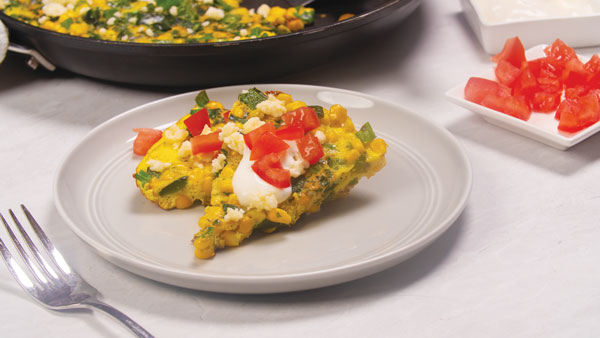
Poblano Frittata
Servings: 4 (2 wedges per serving)
- 4 large eggs
- 1/4 cup fat-free milk
- 2 tablespoons chopped fresh cilantro
- 1 teaspoon olive oil
- 2 medium poblano peppers, seeds and ribs discarded, chopped
- 2 cups frozen whole-kernel corn, thawed
- 2 medium green onions, chopped
- 1/4 cup finely shredded Cotija cheese or crumbled queso fresco
- 1 medium tomato, chopped
- 1/4 cup fat-free sour cream
- In medium bowl, whisk eggs, milk and cilantro.
- In medium skillet over medium heat, heat oil, swirling to coat bottom of skillet. Cook poblano peppers 3 minutes, or until browning on edges, stirring frequently.
- Stir in corn and green onion. Reduce heat to medium-low and carefully pour in egg mixture. Cook, covered, 10 minutes, or until mixture is just set on edges and still soft in center. Avoid overcooking. Remove from heat.
- Sprinkle with cheese. Cut into eight wedges. Place two wedges on each plate. Top with tomatoes and sour cream.
Nutritional information per serving: 244 calories; 8.5 g total fat; 2.5 g saturated fat; 1.5 g polyunsaturated fat; 3 g monounsaturated fat; 192 mg cholesterol; 177 mg sodium; 27 g carbohydrates; 4 g fiber; 8 g total sugars; 13 g protein.
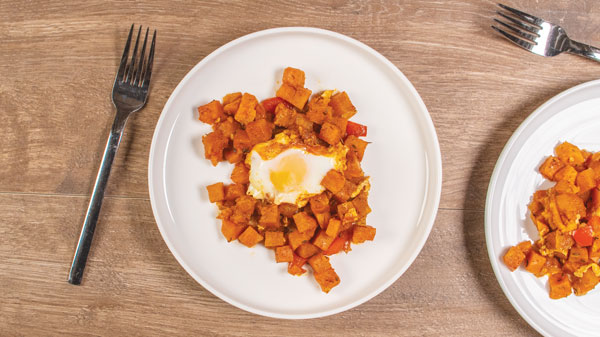
Sweet Potato Hash with Eggs
Servings: 4 (1 cup per serving)
- 2 teaspoons canola or corn oil
- 1/2 medium onion, chopped
- 4 medium sweet potatoes, peeled and cut into 1/2-inch cubes
- 1/2 medium red or green bell pepper, chopped
- 2/3 cup fat-free, low-sodium vegetable broth
- 2 teaspoons minced garlic
- 2 teaspoons smoked paprika
- 1 teaspoon ground cumin
- 1/2 teaspoon dried thyme, crumbled
- 1/2 teaspoon coarsely ground pepper
- 1/8 teaspoon salt
- 4 large eggs
- hot pepper sauce (optional)
- In pressure cooker set on saute, heat oil. Cook onion 3 minutes, or until soft, stirring frequently. Turn off pressure cooker.
- Stir in potatoes, bell pepper, broth, garlic, paprika, cumin, thyme, pepper and salt. Secure lid. Cook on high pressure 3 minutes. Quickly release pressure. Turn off pressure cooker.
- Remove pressure cooker lid. Crack one egg into small bowl. Using back of spoon, make small well in potatoes. Slip egg into well. Repeat with remaining eggs, making separate well for each egg. Secure lid with pressure vent open. Saute 2 minutes. Let stand on “keep warm” setting 2 minutes, or until eggs are cooked to desired consistency.
- Serve hash sprinkled with dash of hot pepper sauce, if desired.
Nutritional information per serving: 258 calories; 7.5 g total fat; 2 g saturated fat; 1.5 g polyunsaturated fat; 3 g monounsaturated fat; 186 mg cholesterol; 244 mg sodium; 39 g carbohydrates; 6 g fiber; 9 g total sugars; 10 g protein.
Source: American Heart Association
Fill Your Family's Plates with Cozy Fall Meals
(Family Features) Putting away the homework, turning off electronics and spending a little quality time together can help ease everyday stresses. Add a cozy meal packed with tastes you love and you’ll have the perfect recipe for an autumn evening with your family.
Cooler days call for comforting flavors the entire family can enjoy at the dinner table like roasted veggies – from sweet potatoes to pumpkin and more – paired with hearty favorites like cheesy pierogies that provide a sense of warmth and coziness. Make this autumn one to remember by creating new meals and memories along the way.
For an extra special celebration with the ones you love in honor of the 15th anniversary of National Pierogy Day, consider a cozy, warming dish like Roasted Sweet Potatoes Brown Butter Pierogies, which is loaded with the flavors of the season. This comforting meal starts with cubed sweet potatoes – a hallmark of fall – along with pierogies tossed in a homemade brown butter sauce. Top with pecans for a nutty crunch and fresh thyme leaves for the final touch on a newfound favorite that’ll bring loved ones running to the dinner table.
At the heart of the dish are Mrs. T’s Pierogies, which are pasta pockets filled with stuff families love like creamy mashed potatoes, cheese and big, bold flavors. Found in the frozen food aisle, they’re available in 13 flavors including 4 Cheese Medley, Loaded Baked Potato, Feta & Spinach and other varieties in full and mini sizes. Pierogies can be boiled, baked, air-fried, sauteed, fried or grilled to leave more time for family and less time in the kitchen.
Find more ways to incorporate fall flavors into your family’s everyday menu by visiting MrsTsPierogies.com.
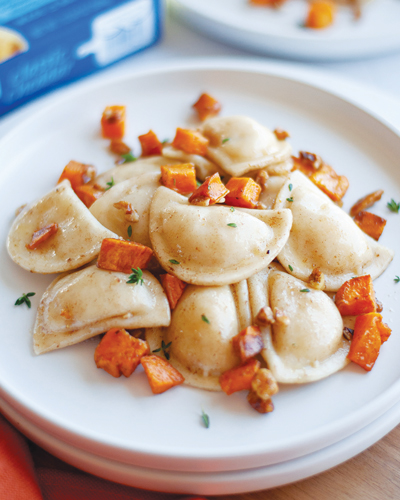
Roasted Sweet Potatoes Brown Butter Pierogies
Prep time: 10 minutes
Cook time: 30 minutes
Servings: 4-5
- 1 bag (1.6 pounds) Mrs. T’s Mini Classic Cheddar Pierogies
- 2 cups sweet potato cubes (approximately 1 large or 2 medium sweet potatoes, cut into 1/2-inch cubes)
- 1 tablespoon olive oil
- salt, to taste
- pepper, to taste
- 4 tablespoons salted butter
- 1 tablespoon balsamic vinegar
- 2 tablespoons lemon juice
- water
- 1/2 cup pecans
- fresh thyme leaves, for serving
- Preheat oven to 400 F.
- Toss sweet potato cubes in olive oil, salt and pepper, to taste, and spread in even layer on baking sheet. Roast 25-30 minutes, tossing about halfway through, until potatoes are fork tender.
- In medium skillet over medium heat, brown butter 5-10 minutes. Avoid smoking or burning. Remove from heat. Allow to cool about 5 minutes then whisk in balsamic vinegar and lemon juice.
- In large saucepan, bring water to boil. Cook pierogies according to package directions, about 3 minutes. Drain and toss in brown butter sauce.
- Add roasted sweet potatoes and pecans to brown butter pierogies and toss gently to coat.
- Top with fresh thyme leaves.
Source: Mrs. T’s Pierogies
Grilled Sweetpotato and Blueberry Salad
(Family Features) Get out of the kitchen and head outdoors this summer for fresh, delicious meals that call for lighting the grill and relaxing in the warmth of the season. Take some of your favorite courses – like salads, for instance – to the next level by adding grilled ingredients for that perfect bit of char.
This Grilled Sweetpotato and Blueberry Salad offers all the tastes of the season with spring salad mix, fresh blueberries, walnuts and blue cheese. Topped with homemade lemon honey vinaigrette, it’s a light yet filling meal fit for warm days thanks in part to the superfood that takes it to new heights: sweetpotatoes.
As one of the most versatile vegetables that’s easy to add to a variety of recipes for flavor and nutrition enhancement, sweetpotatoes can be a key ingredient in simple or elevated, sweet or savory dishes alike. Whether they’re cooked on the stove, baked, microwaved, slow-cooked or grilled to a perfect doneness with a crispy char, they can be an ideal addition to better-for-you summer meals.
Plus, they’re a “diabetes superfood” per the American Diabetes Association because they’re rich in vitamins, minerals, antioxidants and fiber, all of which are good for overall health. When enjoyed with the skin on, one medium sweetpotato contains more than 100% of the recommended daily amount of vitamin A, an important vitamin affecting vision, bone development and immune function. They’re also a good source of fiber and rich in potassium.
Another fun fact: the National Sweetpotato Collaborators officially adopted the one-word spelling in 1989 to avoid confusion with equally unique and distinctive potatoes, which are also grown and marketed in the U.S. Sweetpotato is a noun, not an adjective, meaning “sweet” is not a descriptor but part of the actual nomenclature. This is different than other potatoes using adjectives like white, red or russet to describe an entirely different vegetable.
Find more nutritional information, fun facts and summer recipe ideas at NCSweetpotatoes.com.
Watch video to see how to make this recipe!

Grilled Sweetpotato and Blueberry Salad
Recipe courtesy of the North Carolina Sweetpotato Commission and Andrea Mathis (beautifuleatsandthings.com)
Servings: 4
Lemon Honey Vinaigrette:
- 6 tablespoons olive oil
- 1/4 cup lemon juice
- 2 tablespoons Dijon mustard
- 2 1/2 tablespoons honey
- salt, to taste
- pepper, to taste
- 3 medium sweetpotatoes, peeled and sliced
- 2 tablespoons olive oil
- salt, to taste
- pepper, to taste
- 4 cups spring salad mix
- 1 cup fresh blueberries
- 1/3 cup chopped walnuts
- 1/4 cup blue cheese crumbles
- lemon wedges, for garnish (optional)
- To make lemon honey vinaigrette: In bowl, mix olive oil, lemon juice, Dijon mustard and honey. Season with salt and pepper, to taste. Refrigerate until ready to serve.
- Preheat grill to medium heat. Drizzle sweetpotatoes with olive oil and season with salt and pepper, to taste. Grill sliced sweetpotatoes on each side about 5 minutes, or until sweetpotatoes are tender and slightly charred. Remove from grill and let cool.
- To arrange salad, spread spring salad mix onto large platter and top with grilled sweetpotatoes, blueberries, walnuts and blue cheese crumbles.
- Top with lemon honey vinaigrette and garnish with lemon wedges, if desired.
Sweetpotato Summer Rolls
(Family Features) Summer adventures can often take people just about anywhere, from down the street at the neighborhood pool to across the country on a family road trip. Wherever the action takes you this summer, remember to stay refreshed and energized with easy snacks that provide the nutrition you need.
For example, these Sweetpotato Summer Rolls offer a flavorful way to recharge after some time in the sun. Made with peanut butter, celery sticks and North Carolina Sweetpotatoes, they’re ideal for serving your family following a day of fun.
Classified as a “diabetes superfood” by the American Diabetes Association, sweetpotatoes are rich in vitamins, minerals, fiber and antioxidants, all of which are good for overall health. Plus, they offer a natural sweetener without the added sugar.
Consider these additional sweetpotato facts as you prepare for summer excitement.
Versatile
As one of the most versatile vegetables that’s easy to add to a variety of recipes for enhancing flavor and nutrition content, sweetpotatoes can be a key ingredient in both simple or elevated and sweet or savory dishes. They can be cooked and prepared on the stove, baked, microwaved, grilled or slow cooked.
One-Word Spelling
“Sweetpotato” should be spelled as one word, even if you aren’t familiar with that spelling. In fact, the North Carolina Sweetpotato Commission deliberately spells it as one word (a practice adopted by the National Sweetpotato Collaborators in 1989) as a way for shippers, distributors, warehouse workers and consumers to avoid confusion with the equally unique and distinctive white potato or yam.
Shelf Life and Storage
Not only are sweetpotatoes abundant and found in just about any grocery store or farmers market, but they also have a long shelf life – up to 4 weeks if stored properly in a cool, dry, well-ventilated area away from heat sources.
Ideal for Athletes
Due to their high carbohydrate content, sweetpotatoes are solutions for both before and after exercise sessions. With complex carbohydrates that provide sustained energy and antioxidants that help reduce inflammation and aid in muscle repair, sweetpotatoes can elevate both endurance and recovery.
Find more summertime recipe ideas by visiting ncsweetpotatoes.com.
Watch video to see how to make this recipe!
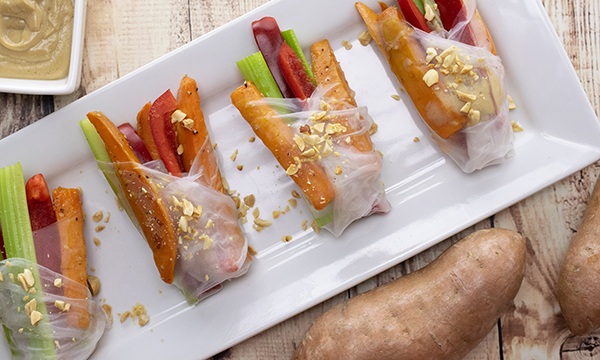
Sweetpotato Summer Rolls
Recipe courtesy of the North Carolina Sweetpotato Commission
Servings: 4
- 2 1/2 cups North Carolina Sweetpotatoes
- 2 tablespoons olive oil
- 2 teaspoons sesame seeds
- 3 tablespoons maple syrup
- salt, to taste
- coarse pepper, to taste
- 4 celery sticks
- 1 red pepper
- 2 tablespoons creamy peanut butter
- 1/3 cup hot water
- 1/4 cup soy cooking cream
- 1 tablespoon soy sauce
- 12 sheets rice paper (22-centimeter diameter)
- 2 tablespoons chopped, roasted peanuts
- Peel sweetpotatoes and cut into 1-centimeter thick strips.
- In skillet, heat olive oil. Fry sweetpotato strips 3-4 minutes, turning occasionally; sprinkle with sesame seeds, deglaze with maple syrup and boil down briefly. Season with salt and pepper, to taste, and let cool.
- Wash celery and red pepper; cut into strips.
- Mix peanut butter with water, cream and soy sauce.
- Let rice paper sheets swell according to package instructions.
- Spread strips of sweetpotato, celery and red pepper on top half of one sheet rice paper. Drizzle with sauce. Fold lower half over strips then edges.
- Repeat with remaining rice paper sheets and ingredients. Sprinkle summer rolls with chopped peanuts. Serve with remaining sauce.
Dishing Out the Facts on Good Fats
(Family Features) For those seeking to be more health-conscious, the idea of eating nutritiously seems simple. However, understanding what’s truly “good for you” can sometimes be confusing.
In honor of National Nutrition Month and Healthy Fats Day, Avocados From Mexico is sharing how avocados – a delicious food and source of good fats and several vitamins – make everything better. Avocados From Mexico conducted a survey and found that while 76% of respondents believe fat is an essential component of a healthy diet, less than one-third are confident they know why it’s important to have “good fats” in their diets.
For starters, according to the survey, nearly half of Americans didn’t realize foods with good fats, like avocados, can help with weight management. However, monounsaturated and polyunsaturated fats found in avocados can lower the risk of becoming overweight, according to research published in “Nutrients.”
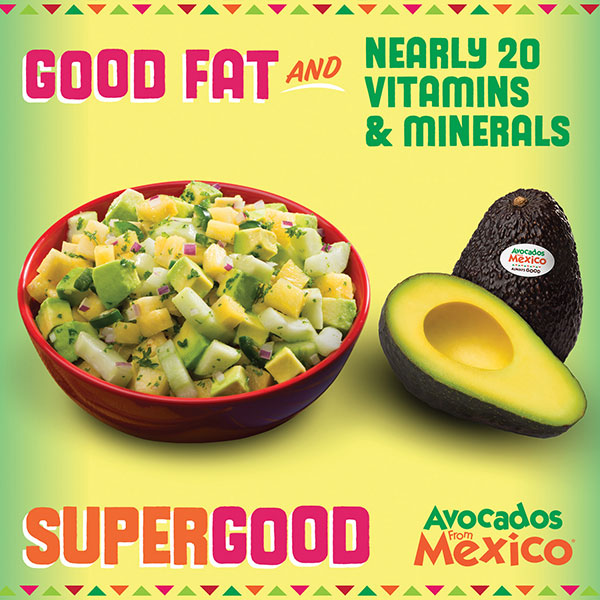 “Most people are aware of the Mediterranean Diet, but nearly half (40%) of survey respondents didn’t realize that this eating pattern does not limit fat coming from plantsources like avocados,” said nutrition expert and registered dietitianBarbara Ruhs. “These types of unsaturated good fats are also recommended by the American Heart Association for heart health. Eating avocados in place of foods containing saturated fat is an easy and delicious way to approach healthy eating.”
“Most people are aware of the Mediterranean Diet, but nearly half (40%) of survey respondents didn’t realize that this eating pattern does not limit fat coming from plantsources like avocados,” said nutrition expert and registered dietitianBarbara Ruhs. “These types of unsaturated good fats are also recommended by the American Heart Association for heart health. Eating avocados in place of foods containing saturated fat is an easy and delicious way to approach healthy eating.”
Virtually the only fresh fruit with good fats, avocados can help people meet both good fat and fruit and vegetable recommendations in the same bite with approximately 6 grams of good fats per serving (one-third of a medium avocado). They are nutrient-dense, making avocados a delicious food with super benefits. Avocados are also free of cholesterol and sodium and have nearly 20 vitamins and minerals.
Another finding from the survey is that while people believe fat is essential to a healthy diet, one-third of survey respondents believe saturated and trans fats are associated with health benefits, indicating confusion about the various types of fats. Many Americans need to balance their overall fat intake by reducing “bad” or saturated fat intake and increasing “good” or unsaturated (monounsaturated and polyunsaturated) fat intake. Replacing saturated fats with unsaturated fats can help reduce LDL, or bad cholesterol levels.
Dietary fat helps the body absorb vitamins A, D, E, and K. These vitamins are fat soluble, which means they can only be absorbed by the body with the help of fats. Per one-third of a medium avocado (50 grams), avocados contribute 6 grams of unsaturated fats, which are known to be essential for normal growth and development of the central nervous system and brain.
Make good fats a part of your next trip to the grocery store with this avocado-inspired Harvest Bowl Salad with Balsamic Vinaigrette certified by the American Heart Association’s Heart-Check Food Certification Program.
To find more nutritional facts and figures, along with recipes, visit AvocadosFromMexico.com.
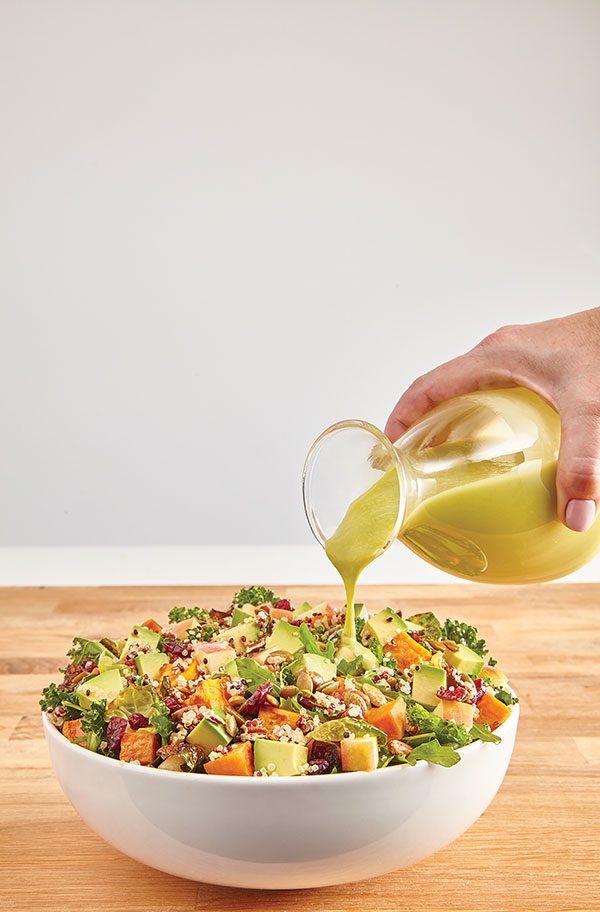
Harvest Bowl Salad with Balsamic Vinaigrette
Servings: 8
Balsamic Vinaigrette:
- 1/2 Avocado From Mexico, diced
- 1 tablespoon avocado oil
- 2 tablespoons shallots, minced
- 1 tablespoon Dijon mustard
- 3 tablespoons white balsamic vinegar
- 1 tablespoon honey
- 3 tablespoons water
Salad:
- 2 Avocados From Mexico, diced
- 2 sweet potatoes, roasted and diced
- 2 cups quinoa, cooked
- 2 cups arugula
- 2 cups kale
- 1 cup Brussels sprouts petals, roasted
- 2 Honeycrisp apples, diced
- 2 tablespoons roasted pecans, unsalted
- 2 tablespoons roasted pepitas, unsalted
- 2 tablespoons dried cranberries
- To make balsamic vinaigrette: In food processor, process avocado, avocado oil, shallots, Dijon mustard, balsamic vinegar, honey and water to smooth consistency. Set aside.
- To make salad: In large bowl, combine avocados, sweet potatoes, quinoa, arugula, kale, Brussels sprouts petals, apples, pecans, pepitas and dried cranberries. Pour balsamic vinaigrette over salad mixture.
- Toss salad to coat. Keep refrigerated until ready to serve.
Nutritional information per serving: 390 calories; 16 g total fat; 0 g saturated fat; 0 g cholesterol; 370 mg sodium; 55 g total carbohydrates; 11 g dietary fiber; 12 g sugar; 15 g protein.
Sweetpotato Power Salad
(Family Features) Bright, beautiful spring days often call for fresh, delicious meals that give you energy to enjoy the great outdoors. Whether you’re hitting the pavement for a run, powering up for an afternoon at the office or picnicking with loved ones, nutrition and flavor can go hand in hand with an easy-to-make salad.
For your next springtime meal, lean on a versatile ingredient like sweetpotatoes as a key ingredient in this Sweetpotato Power Salad, a light yet filling solution that can feed the whole family. Easy to add to a variety of recipes to enhance flavor and nutrition content, sweetpotatoes can be used in sweet, savory, simple or elevated recipes. Plus, they can be prepared on the stove, baked, microwaved, grilled or slow cooked to fit your favorite dishes as a natural sweetener without added sugar.
According to the American Diabetes Association, sweetpotatoes are a “diabetes superfood” because they’re rich in vitamins, minerals, antioxidants and fiber, all of which are good for overall health. Due to their high carbohydrate content, they’re an ideal option for athletes before and after exercising with complex carbohydrates that provide sustained energy. Additionally, the antioxidants help reduce inflammation and aid in muscle repair, meaning sweetpotatoes can help both your endurance and recovery.
Another fun fact: the North Carolina Sweetpotato Commission deliberately spells “sweetpotato” as one word, a spelling officially adopted by the National Sweetpotato Collaborators in 1989 to avoid confusion with the white potato or yam among shippers, distributors, warehouse workers and consumers. However, this spelling isn’t universal; you can help teach others and update dictionary entries by signing the change.org petition to give this superfood its due.
Find more information and springtime recipe inspiration at ncsweetpotatoes.com.
Watch video to see how to make this recipe!
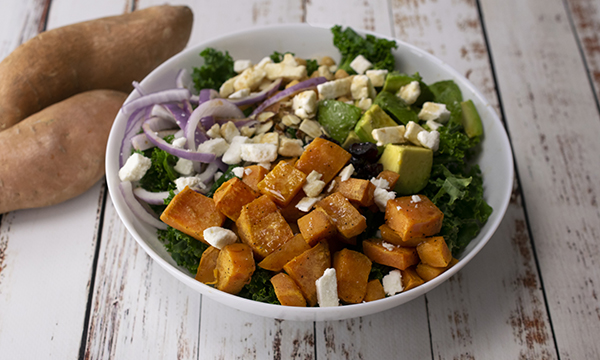
Sweetpotato Power Salad
Recipe courtesy of Carol Brown on behalf of the North Carolina Sweetpotato Commission
Servings: 6
- 4-6 North Carolina Sweetpotatoes, peeled and diced (6 cups)
- 2 teaspoons, plus 1 tablespoon, olive oil, divided
- 3/4 teaspoon salt, divided
- 1/4 teaspoon pepper
- 1 1/2 bunches curly kale, rinsed and chopped (7-8 cups)
- 1/2 large lemon, juice only
- 1 can (15 ounces) garbanzo beans, rinsed and drained
- 1 large avocado, pitted and diced
- 1/2 cup cranberries
- 1/2 cup coarsely chopped almonds
- 1/4 cup red onion, chopped
- 1/2-3/4 cup feta or goat cheese
Dressing:
- 2 tablespoons pure maple syrup
- 2 tablespoons olive oil
- 1/4 cup balsamic or white vinegar
- Preheat oven to 375 F.
- Place sweetpotatoes in large bowl. In small bowl, lightly whisk 2 teaspoons olive oil, 1/2 teaspoon salt and pepper. Toss on sweetpotatoes and place potatoes on large sheet pan. Bake 35-40 minutes until tender, flipping once during baking.
- Place chopped kale in large bowl. In small bowl, lightly whisk remaining olive oil, remaining salt and lemon juice. Pour over kale and massage with hands until mixed, about 1 minute.
- To make dressing: In bowl, whisk syrup, olive oil and vinegar.
- In bowl with kale, add garbanzo beans, avocado, cranberries, almonds, red onion, sweetpotatoes and cheese. Toss with salad dressing and serve.
- Note: Sweetpotatoes can be baked and refrigerated 1 day in advance.
Sweetpotato Foil Packet Tacos
(Family Features) Fall provides almost endless opportunities to gather friends and family around great food. From tailgates and family events to those precious last outdoor meals before winter sets in, the scenery of autumn is a perfect backdrop for sharing meals together.
Those favorite fall foods are often best when they’re delicious without complications. Taking the guesswork out of cool-weather classics can be as easy as these Sweetpotato Foil Packet Tacos, which are loaded with flavor and can be customized to fit everyone’s taste buds with personalized toppings.
As the key ingredient, sweetpotatoes show off their versatility as an ideal addition to simple or elevated, sweet or savory dishes. Because you can cook and prepare them multiple ways – such as baked, microwaved, grilled, slow cooked or on the stove – they’re easy to use in a wide array of recipes.
Plus, according to the American Diabetes Association, sweetpotatoes are a “diabetes superfood” because they’re rich in vitamins, minerals, antioxidants and fiber, all of which are good for overall health and may help prevent disease. Their “sweet” flavor without the added sugar makes them a pantry staple throughout the fall.
Pro tip: Sweetpotatoes are abundant and have a long shelf-life – up to four weeks if stored properly in a cool, dry, well-ventilated area away from heat sources – but never store in the refrigerator as this can cause “chill damage,” leaving them with a hard center and unpleasant taste.
Make the most of your fall meals with family and friends by finding more recipes at ncsweetpotatoes.com.
Watch video to see how to make this recipe!
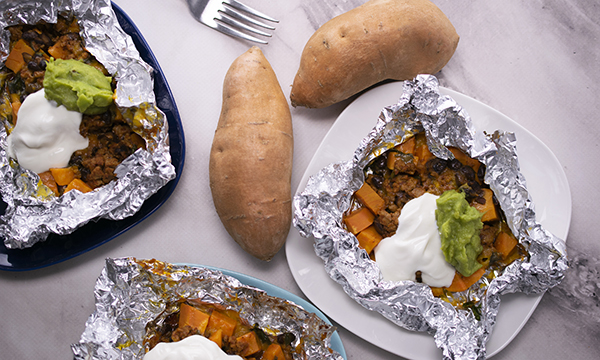
Sweetpotato Foil Packet Tacos
Recipe courtesy of the North Carolina SweetPotato Commission
Servings: 6
- 1/2 pound ground turkey
- 3 tablespoons taco seasoning
- 1/2 cup tomato sauce
- 1 can (15 ounces) black beans, rinsed and drained
- nonstick cooking spray
- 2 pounds North Carolina sweetpotatoes, peeled and cut into 1/2-inch cubes
- 2 tablespoons butter
- 3/4 teaspoon salt
- 1 1/2 cups fresh chopped spinach
- 1 1/2 cups shredded cheddar cheese
- sour cream (optional)
- guacamole (optional)
- Preheat oven to 425 F.
- In skillet over medium-high heat, brown ground meat. Stir in taco seasoning, tomato sauce and beans; set aside.
- Lay out six 12-inch aluminum foil pieces; spray each with nonstick cooking spray.
- In center of each foil piece, place 1 cup sweetpotatoes, 1 teaspoon butter, 1/8 teaspoon salt, 1/4 cup spinach, 1/3 cup taco meat and 1/4 cup cheese.
- Fold foil sides in over mixture; fold top and bottom foil ends inward and seal.
- Place packets on rimmed cookie sheet; bake until sweetpotatoes are tender, about 25 minutes.
- Serve with sour cream or guacamole, if desired.










